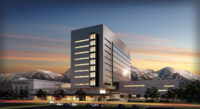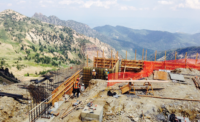Chalk it up to continued high population growth, the dynamic nature of health-care delivery, the need to replace aging facilities or all of the above. But even with a considerable list of projects completed in 2015, officials at Utah’s Intermountain Healthcare say they will invest nearly a half-billion dollars per year for the next three to four years on capital improvements, mostly to expand or build new facilities across the state.
The company says that, from 2005 to 2015, it spent $3.7 billion in capital improvements, with a significant portion of that going to construction—just one of the reasons that the nonprofit health-care provider has been selected as the ENR Mountain States’ 2016 Intermountain Owner of the Year.
Among the company’s projects completed in 2015: a 100,000-sq-ft expansion of the Budge Clinic at Logan Regional Hospital; a 120,000-sq-ft expansion of the Riverton Hospital; and new clinics in Draper and American Fork, both of which earned Best Projects recognition from ENR Mountain States last year.
At the end of 2014, Intermountain Healthcare opened a $128-million, 230,000-sq-ft expansion of its regional pediatric facility, Primary Children’s Hospital, in Salt Lake City.
No Slowdown
The largest project launched by the company so far in 2016 is the expansion and partial replacement of Utah Valley Medical Center, in Provo. Last year, Salt Lake City-based Jacobsen Construction was awarded a $259-million CM-GC contract for the project. Designed by architectural and engineering firm HDR, the facility will include a 12-story, 590,000-sq-ft inpatient tower, plus a 107,000-sq-ft outpatient services building. Completion is scheduled for fall 2018.
This spring, Intermountain Healthcare announced it will begin construction of a new 220,000-sq-ft hospital and 100,000-sq-ft professional building in the city of Layton, about 25 miles north of Salt Lake City. Jacobsen will deliver the HKS-designed project on a CM-GC contract.
Farther north in Ogden, Okland Construction, Salt Lake City, currently is working on the 81,000-sq-ft McKay-Dee Orthopedic Surgical Center, designed by HKS. The $27.1-million facility is scheduled for completion this summer. Okland also will be the builder for an expansion and partial replacement of Intermountain Healthcare’s Alta View Hospital, in Sandy, southeast of Salt Lake City.
Partners in Construction
Intermountain Healthcare’s major capital expenditures are financed through a number of channels, including issuance of municipal bonds, earnings from operations and investments, donations, and draws from reserves, according to a company statement.
“We are very mindful of not being wasteful with what we already have. But we want to make sure we are planning and building in a manner that is consistent with our strategy to enhance the overall well- being of our patients and members,” says Clay Ashdown, vice president of capital development and financial planning at Intermountain Healthcare. “When we identify a need in a community, either from growth or if there have been changes to the way we deliver care, we look at that from a community and a business perspective and look for ways to resolve those issues. Sometimes that will [mean] replacing a facility, but it is different in each area.”
Ashdown says the company has an internal planning and development department, which has six licensed architects and support staff, that evaluates and develops projects and may also do project management, depending on the size and complexity of the task.
Intermountain Healthcare also looks to outside architectural firms for design, partnering with Salt Lake City-based VCBO, Perkins + Will and ZGF, as well as HDR and HKS on past and current projects, Ashdown adds.
“We’re also fortunate to have several very qualified and competent contractors here, and if we are doing a project of significant size, we’ll look at a CM-GC delivery,” Ashdown says. “The partnership between our team and the contractor is very complementary, and we’ll look to the contractor for things like scheduling, estimating and value engineering. On those large projects, we really rely on the contractor.”
Rich Thorn, president of the Utah chapter of the Associated General Contractors, says the company is a valuable and respected partner in the Utah building community. “Intermountain Healthcare is held in high esteem among our members,” he says. “When you look at construction across Utah, there are few owners who have touched as many communities as Intermountain Healthcare. From the state’s capital to rural Utah, Intermountain Healthcare is either there or not far away. They are not just terrific owner; they are an outstanding corporate citizen and have helped Utah in more ways than most people know.”
Blake Court, vice president at Jacobsen Construction, has managed numerous Intermountain Healthcare projects for his firm. “Intermountain is a unique client for us, partly because their vision is very long term. They recognize what a vital role they play in the communities they serve,” says Court. “They look for someone that shares the same values and will safeguard their funds as much as they do. They like the CM-GC process because they recognize the value of the contractor as a team member.”
Okland Construction completed Intermountain Healthcare’s flagship hospital, Intermountain Medical Center, in Murray in 2007, and the award-winning Park City Medical Center, in 2009. “[Intermountain Healthcare] looks for a GC who will deliver on commitments made early in the project development process,” says John Evans, a vice president at Okland. He has coordinated a number of projects for the health-care provider. “They want a partner who will maintain initial costs, budgets and schedule time frames while looking out for Intermountain Healthcare’s interests throughout the project,” he says.
Both Jacobsen and Okland have worked with Intermountain Healthcare mostly on CM-GC contracts. “Although they do some low bid on smaller projects, most of what we do—the larger projects—are delivered CM-GC,” says Court.
“However, they have been utilizing integrated project delivery as one of their preferred methods on some recent projects,” Evans says. “Intermountain engages their contractors early in the design process. This allows us to integrate with the architect and owner and bring more value to the table. We find we have the most impact on cost, constructibility and schedule during the front end of the design process. Intermountain is exceptional at creating a true partnership.”
Ashdown says the right facility design is a crucial part of delivering quality care, but his company is also vigilant about budgets. “We want to provide the best care possible, and care that is absolutely proper but not more than is necessary,” he adds. “We have best-practice models and try to have designs that facilitate those practices.”
Thorn notes that, as an owner, Intermountain Healthcare pushes builders to do their best work on each project. “Intermountain encourages our industry to think leading-edge,” he says. “They are open to new and innovative ideas on how to build a better product. This flows down to construction in many other sectors across the state.”
Jacobsen’s Court agrees. “[Intermountain Healthcare’s project managers] evaluate every detail, from energy efficiency to ease of access, to provide the very best health care possible, without adding unnecessary options that don’t enhance the quality of care.”
Ashdown says his company’s goal is to “be nimble [enough] to respond to the population we serve. That population is growing. We have to be prepared to handle that growth, and we want to be flexible without going too far out on a limb.”
A Health-Care System With Community Roots
Based in Salt Lake City, the Intermountain Healthcare system was founded in 1975, when the hospitals owned and operated by the Church of Jesus Christ of Latter-day Saints were turned over to the communities they serve.
Since its founding, Intermountain Healthcare has grown into an integrated health-care system, with multiple divisions and operating facilities that offer several innovative health plans. Data from the Utah Office of Economic Development shows that, with 36,000 employees, the health-care provider is the state’s largest private employer.
The company currently operates 22 hospitals in Utah and one in Burley, Idaho. Intermountain Healthcare also incorporates 185 clinics and urgent-care facilities, run by physicians as part of the Intermountain Medical Group.
In total, Intermountain Healthcare operates more than 160 health-care facilities, employs about 700 of Utah’s 4,600 physicians and provides insurance to about 19% of Utah residents.
Volunteer boards of trustees still direct facilities’ operations in different areas of the state, guided by a volunteer governing board that sets corporate goals and evaluates management performance. The board is led by Chair A. Scott Anderson, also president and CEO of Zions First National Bank.
Intermountain Healthcare’s current president and CEO is physician Charles W. Sorenson.







